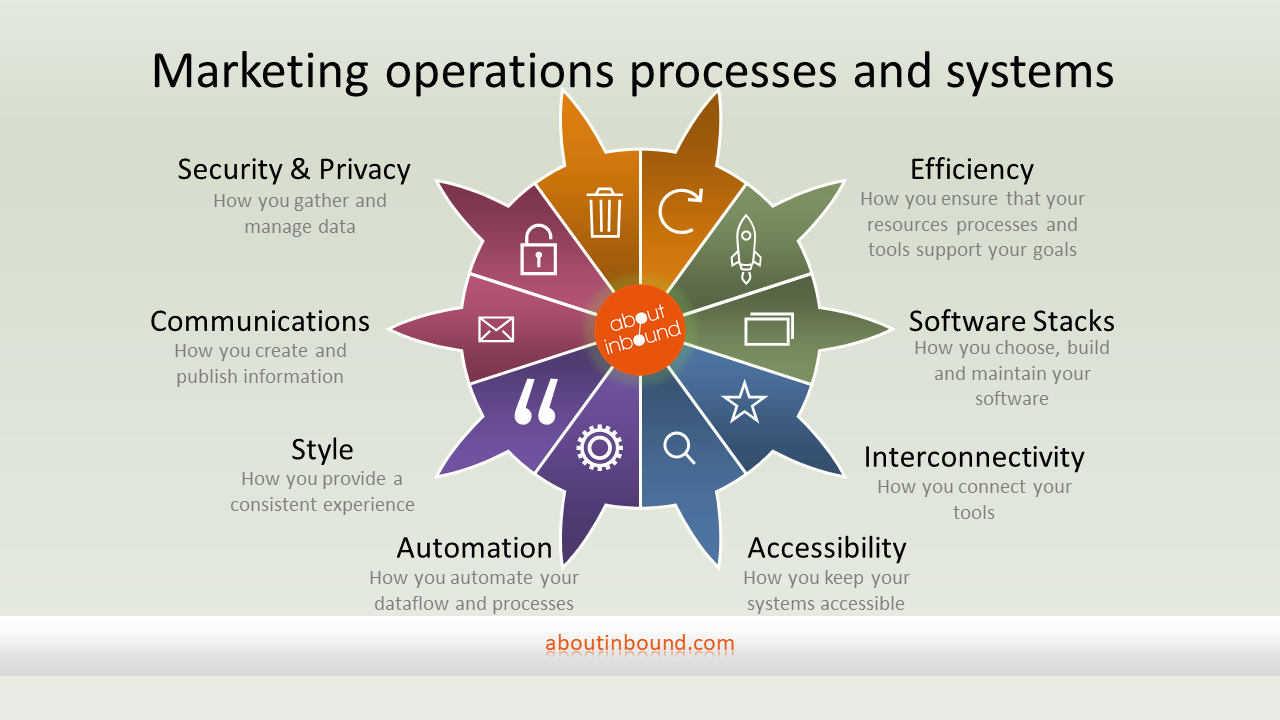In this blog post we’ll look at the general operations tasks that you should focus on as part of your marketing efforts. We'll explore the different types of marketing operations tasks and provide you with examples of tasks that are often missed. We will illustrated what happens when these are neglected. we will also provide you with a checklist to see if you have got your marketing operations under control.
If you are like most modern marketing professionals, you will have likely played an active role in building tailored marketing, sales and CRM based systems. You will probably have tried to integrate these as much as possible and to automate many of the processes between these systems. This has likely allowed you to achieve more aggressive targets, given you a better overview of how all the different parts of your marketing and sales efforts perform and helped your customer facing departments work together better.
Unfortunately, there are some nasty side effects that can occur when your marketing sales and CRM systems grow in complexity and scope. At About Inbound we have seen many businesses being confronted with databases that grew out of control, automation that that has run away from them and systems with unfindable or unusable data. This is often accompanied by under performing processes that no-one dares to touch because their workings and the reasons for their implementation has become a mystery. Dealing with these runaway tools, datasets and processes tends to cost lots of time and money. It can make content perform poorly and can cause entire platforms to become just cost centers instead of growth drivers. This is why the marketing operations tasks to maintain your systems need to be a part of the plan for every marketing team. The good news is that a lot of these marketing operations tasks can be implemented at any stage to improve the workings of your marketing department. It is never too late to correct what is not working.
What are Marketing Operation tasks?
Marketing Operations is a very broad term. There are literally 100's of different activities that can fall under marketing operations. The term is used for a broad range of marketing methods. It is mentioned when planning out reports and planning out activities to support your marketing goals, but also used when looking at leads quality or dealing with under performing systems. This makes it quite a global term. To make it more understandable let’s try to summarise this in one sentence:
Marketing operations represent the tasks and processes that should allow your marketing systems to run smoothly and your marketing strategies to become and stay effective.
There is quite a bit of talk and content around the strategic parts of marketing operations and they are often well defined using existing methodologies. With every high level goal and its underpinning actions there is a clear need for these operations tasks and these goal oriented tasks are often already a part of the daily efforts of every marketing team. It is the smaller more maintenance oriented operations task that does not seem directly relevant to reaching growth targets that is often overlooked. When there is not enough focus on these less goal-oriented tasks, extra time is often lost and problems start to occur within your marketing and sales systems. With marketing operations, the devil is very much in the detail.
Why do maintenance tasks often get missed by growth marketing teams?
To see why marketing operations tasks often get missed it might help if we try to divide them into two types:
1. Marketing operations tasks that are related to implementation and strategy.
These are the tasks that allow you to set and accomplish your marketing goals. They are connected to implementing new things and adding new functionality. They are often more high level and goal oriented. Some examples of these types of tasks are:
- The creation of new reports for marketing and sales pipelines.
- The implementation of structured meetings and a feedback to create and track new goals.
- The implementation of a content schedule.
- The creation and of a campaign schedule.
- The implementation and improvement of lead scoring practices.
- Creating a style guide to improve website consistency.
- Implementing automated workflows to manage data
As you can see you can easily relate these tasks back to accomplishing business and brand growth goals. This means that they don’t get overlooked as easily. They can be clearly linked to results.
2. Marketing operations tasks that are related to maintenance and processes.
These are the tasks that do not directly relate to a business growth goals. It’s harder to see why they are important but they should not be neglected.
Let’s look at a quick analogy of why they are as important as the tasks that directly underpin your growth goals:
Compare your growth strategy with a tree (Stay with me here).
Imagine that our mission and objectives are its roots
Our growth goals and their activities drive the growth of our branches and leaves allow our tree to catch the sun and grow.
Our maintenance tasks sit in our main tree trunk – they allow water to flow up (automation), they allow the tree to support the weight of the branches. They withstand the force of the growth.If you do not keep your main trunk healthy, you restrict the trees growth, or worse you might cause it become brittle and risk that the tree falls over during a storm.
Here are some examples of systems maintenance tasks that are often neglected in Hubspot and other SAAS suites:
- Reducing the unusable contact records in your CRM by deleting duplicates and removing incomplete records.
- Renaming contact segments (lists) in your CRM to make them consistent, recognisable and describe their use.
- Creating a consistent file structure in your CMS to keep your web assets findable and usable.
- Reducing picture file sizes and resizing their dimensions to make sure that they scale properly and load faster across all web pages.
- Archiving and removing obsolete content
- Disabling and clearing out unneeded automation
- Managing accounts to ensure the right levels of access and rights to software features, assets and user data.
As you can see these tasks are not very appealing. Most of them don’t seem to directly relate to accomplishing any goals. They often sit between responsibilities of different departments such as IT, Marketing, sales and communications. They cut across many different roles and responsibilities too. They affect everything from SEO in content marketing to vendor management. It’s therefore very hard to keep a clear focus on them, but it is very important that you implement these within your growth marketing strategy.
Here is why you should spend more time on marketing operations tasks to achieve your growth goals:
To help you better understand the impact marketing operations have on your results I wrote out some scenarios. In the examples below marketing departments missed out on some of the maintenance focused marketing operations tasks while implementing their growth strategies. This had a significant negative impact on the results. These examples are based on some of our experiences with our customers and the marketing operations challenges we assist them with. We also encounter many of these challenges in our own marketing efforts.
Marketing operations issues scenario 1:
At the beginning of the year a goal is set by senior management at a mid-size organisation to attract more leads. A plan is put in place for events, campaigns and additional content and promotion to improve content and increase the flow of visitors to it. A budget is also set for the software and tools cost and subscriptions.
The strategy seems to run smoothly and the marketing reports show that the new content generates a lot of new leads in the system. Everyone is happy... until after 6 months’ the sales managers ask for an interdepartmental meeting.
They are very frustrated as there aren’t enough SQL’s (sales qualified leads) coming through and sales are struggling to meet their targets.
After some discussion and a lot of investigation the marketing managers find that the quality of the additional contacts generated by the activities is low.
Further digging shows that contact information and the information needed to qualify the leads is often missing from the new leads. A lot of duplicate contact records have also been created in the CRM database since the start of the year. Senior management had not found out about this because their reports did not show lead quality and lead qualification was not set up correctly.
This means that while on paper, the marketing department is meeting its target, in reality they have not provided sales with the needed pipeline of quality leads which means that the organisations growth targets for new customers cannot be met. Their CRM software subscription costs have also increased as their CRM database has grown a lot with all the low quality contact records.
Marketing operations issues scenario 2:
A global company with a decentralised marketing department that has many local marketers decides to increase their lead nurturing efforts based on automated emails. They train their location marketing teams on how to create the lead nurturing automation. They set a minimum delay between emails that is in tune with their sales cycle. They create documentation on how to build the email templates. They instruct their local marketers on how to create lead nurturing work flows to underpin their local campaigns.
The initial results look promising. The nurtured contacts are more engaged and more of them seem to convert into qualified leads.
Towards the end of the year, the local marketers start to complain that it takes a long to create the lead nurturing automation. Sales reps also start complaining that many of their contacts say that they are getting way too many emails and find this frustrating. Some of these leads actually contact sales reps because they are irritated with the amount of unneeded mails they receive and just want this stopped. They find that they sometimes still receive email if they unsubscribe.
It turns out that the local marketers have not been naming their automation and contact segments for their lead nurturing campaigns clearly because no standards were set for naming. Automation was also not turned off when campaigns were over. This resulted in lots of automated actions happening for contacts that are no longer needed. It also causes the local marketers problems when they try to find their own lead nurturing automation sets. This causes some marketers to accidentally modify the wrong lead nurturing emails which causes contacts to receive irrelevant and badly timed information. In some cases, it even means contacts end up being enrolled in multiple lead nurturing campaigns at the same time. These contacts are being sent 3 times more emails they should be getting!
Marketing operations issues scenario 3:
The CMO of a mature start-up wants to substantially increase organic lead generation. The plan is to rapidly increase blog content to attract more website visitors and convert them into leads. The marketing manager agrees to use internal and external content creators to create around 100 new blog posts during the year. They brainstorm topics that would resonate with their target accounts and leads. They set aside budget. They plan frequent marketing operations meetings to discuss progress on the planned content, generate more content ideas and keep an eye on the results.
Initial all seems go smoothly. The number of content pieces steadily increases and after 2 or 3 months a steady increase in visitor numbers is seen.
Then halfway through the year the problems start. The website seems to perform sluggishly. There seem to be almost no mobile visitors to the new content. The content marketers are complaining that they are having trouble finding images for their posts (there has been no guidance about this) and some can’t even find the draft posts they have been working on.
When the CMO gets the marketing managers to look into this, it turns out that there has been wildly inconsistent naming or storing of these assets making it very hard to find them in the back end of the CMS. This has happened because there are no naming conventions for content pieces or images and there is no standardised folder structure to store them in. Furthermore, the images used are wildly inconsistent and the sizes of images vary throughout. The quality and size has not been taken into account or tested across devices when the content was created. Some of the larger images cause very slow load times and don’t scale properly on mobile devices while some of the smaller ones look horrible on computer monitors. Googles SEO scores of the content is impacted negatively because of the long load times and display issues. This will take a long time to correct.
In all of these scenarios there are obviously quite a few Marketing Operations tasks that are executed well. The more goal and growth strategy tasks were taken into account in all the scenarios above. Unfortunately, the more technical less goal oriented activities that sit between Marketing and systems management were overlooked. I hope that this shows how these seemingly unimportant tasks have big impact on the quality and cost of your marketing efforts.
Marketing operations questions you should ask yourself when you implement your marketing strategy:
To avoid getting caught out when you put together that next big strategy or when you build out your growth marketing tactics for the year, here are some questions to keep in the back of your head:
- Am I clear what all the systems in my growth stack and their integrations are used for?
- Do I have standards and documentation in place on the implemented lead qualification and automation?
- Are my web and media assets stored in a standardised and consistent way and is this documented?
- Do I have standards and documentation to define how my leads are qualified and nurtured through my automated systems?
- Are my systems and methods in good enough shape to accommodate my plans for growth and outsourcing?
- Am I making sure that my database contains only usable data? Have I got procedures and resources in place to help me keep my CRM data clean?
- Do I have clear procedures in place to safely outsource some of my growth marketing activities without compromising the consistency of my brand and the privacy of my audience?
- Are there clear roles and responsibilities set out for the different marketing assets and the maintenance of the customer data?
If you answered no to any of these questions it might be worth deploying some resources to address them so that you can make sure you systems keep running and your growth targets remain attainable.
If you need any further help with or training for marketing operations or inbound principles don't to contact us for a chat!




